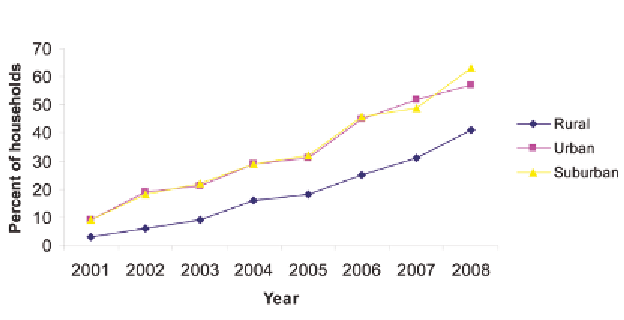Information Technology Reference
In-Depth Information
type of Internet access. In other words rural and
urban households with broadband Internet access
have similar on-line behavior patterns; rural and
urban households with dial-up Internet access have
similar on-line behavior patterns; but broadband
and dial-up households have dissimilar on-line
behavior.
Overall, three-quarters of all adults have Inter-
net access with 69 percent having access at home;
55 percent of all adults have broadband access at
home. Rural households are less likely to have
broadband access with only 41 percent of adults
in rural households having broadband access at
home. Home broadband Internet access has in-
creased for urban and rural households (Figure 1).
On-line pursuits diverge between dial-up users
and broadband users, but not between rural and
urban broadband users (Horrigan, 2008). Broad-
band Internet users were more likely than dial-up
users to take part in any specific on-line activity,
such as getting news on-line (table 1). The more
data intensive the on-line activity, the greater the
difference between dial-up and broadband user
participation rates becomes, especially such ac-
tivities as watching video and downloading
podcasts.
Most adults get on-line everyday (Table 2).
Daily use of the Internet is mostly for e-mail, but
many other pursuits also take place. Getting in-
formation is one of the most common activities,
including visiting state and local government
web-sites. Many on-line activities are of a per-
sonal nature, such as hobbies and web-surfing,
but activities are often also related more directly
to work. Twenty-three percent of adults used the
Internet to conduct research for their job in the
24 hours prior to being surveyed.
In the U.S. economy one major trend with the
new technology has been towards disintermedia-
tion, or eliminating or reducing the economic
involvement of the broker and other business
middlemen. More consumer bank transactions,
for example, are taking place through ATMs or
on-line instead of on-site through the teller win-
dow. According to a PEW survey in 2005 a quar-
ter of all American adults, or 44 percent of all
adult Internet users, use the Internet for on-line
banking. On any given day 14 percent of all
American adults perform some on-line banking
activity (Table 2), including paying bills or trans-
ferring money. Internet users with broadband
access are especially heavy users of on-line bank-
ing services as over 60 percent of urban and
nearly 50 percent of rural broadband users con-
ducted some on-line banking activity by 2007.
Most, if not all, on-line activities are becoming
more highly developed and complex, using more
data intensive methods, especially graphics. Even
Figure 1. Trends in home broadband adoption by region (Source Horrigan, 2008)

Search WWH ::

Custom Search